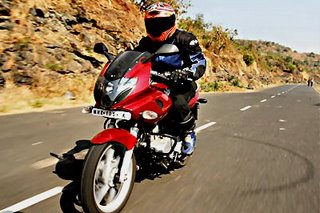Some people are upset about how long it has taken Bajaj to get the Pulsar 220 DTS-Fi off the AutoExpo'06 showstand and into showrooms – a bit more than a full year. Regular sales are expected to begin next month. We haven't seen a launch like this before, with so much speculation, excitement and lots of information preceding the launch. Enthusiasts (and indeed, the competition) knew a fair bit of what was coming and this fuelled the anticipation of one of the most important motorbike launches in India recently.
There are a number of reasons why the 220 is such a fulcrum. First, the market. With margins under pressure and competition rising, the segment in focus is the premium segment – one which Bajaj has more or less 'owned' since they launched the first Pulsar years ago. It is where bike makers can make half decent per-unit margins and inasmuch, the sales 'subsidise' more price-competitive segment sales to some degree. Second, the premium bikes have (admittedly on a smaller base) grown at a pace that far outstrips the sales of entry/executive commuters. This is where the action is.
Third, most bike makers realise that we are ready to hop, skip and jump up the pecking order. What remains to be seen are the actual volumes. The flop that was the BMW Funduro and the long but ultimately futile attempt to launch the Yamaha Drag Star are signs of scared MBAs out there who won't nod 'Yes' to big bikes,
unless they see precedents.
The 220 should set that precedent. Enthusiasts already know the impressive spec list by heart. There is lots of new technology on the bike, including fuel injection, tubeless tyres, projector headlamps, LED tail lamps etc, each with a clear benefit and application. Despite which, Bajaj have pulled out a rabbit-from-a-hat price tag. All that costs only Rs 83,595 on-road Pune.
e road tested the bike, and it is no less impressive in the flesh. We aren't sure that making all Pulsars look so similar is such a great idea, but the 220 does have presence. The 220cc motor is good for 20.5 bhp – it destroys all previous 0-100 kph and top speed times for bikes. But making a bigger motor go faster is easy. What is really great is the 220's dynamic ability. Despite being a fair bit longer than the smaller Pulsars, the 220 is very quick and confident in corners, and most bikes in India would find it hard to keep up. That it rides very well over broken roads and brakes with great composure is a bonus. What we're saying is that on the whole – product, packaging and pricing – Bajaj have more or less hit the nail square on the head. I wouldn't be surprised at all if there aren't enough 220s to go around. Rs 90,000 has a way of disappearing when broken up into EMIs.
If this happens, it will send the right signals to other marques. The Hero Honda Karizma, already rumoured to be in for upgrades, will feel the brunt of the heat. Its displacement and price put it directly in the 220s crosshairs and in its current spec, it will find the road uphill. Unexpected 220 sales volumes will also push companies like Honda and Yamaha, who in product range terms are at the cusp of entering the premium segment with competitive motorcycles. Rumours are rife that Yamaha have a 220-sized product in the final stages. Even if untrue, it's a good rumour. If I were Yamaha, that's what I'd be doing.
The Bajaj 220, in essence, is opening a door to higher displacements to the average Indian motorcycle enthusiast. Bajaj have already stated on record that they have a larger displacement platform in development. We expect a 300 or 400cc single around September 2008 to be the first product from that platform. Other manufacturers, including the three Japanese marques, are also looking for ways to directly import bigger capacity motorcycles to India shortly. Like we said, this is where the action is.
Source:- BsMotoring











1 comments:
Loved readingg this thank you
Post a Comment